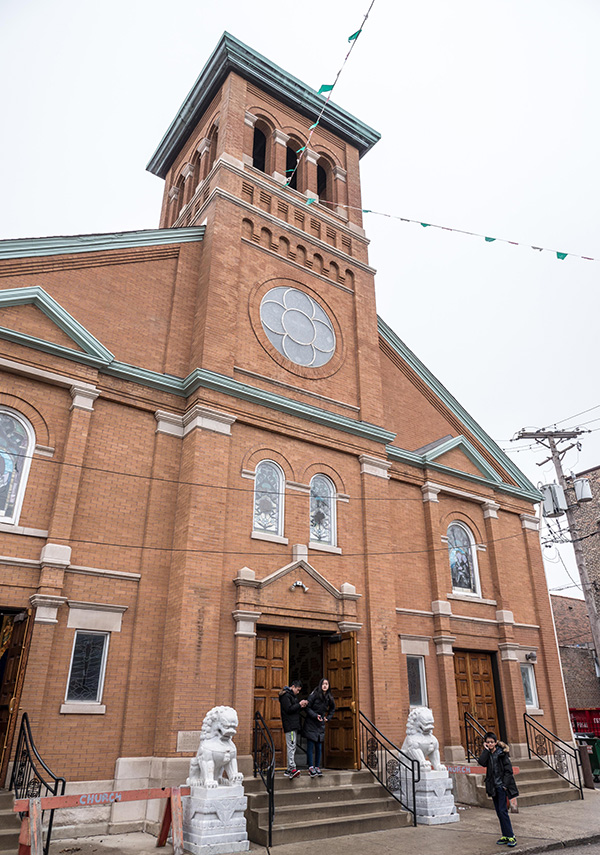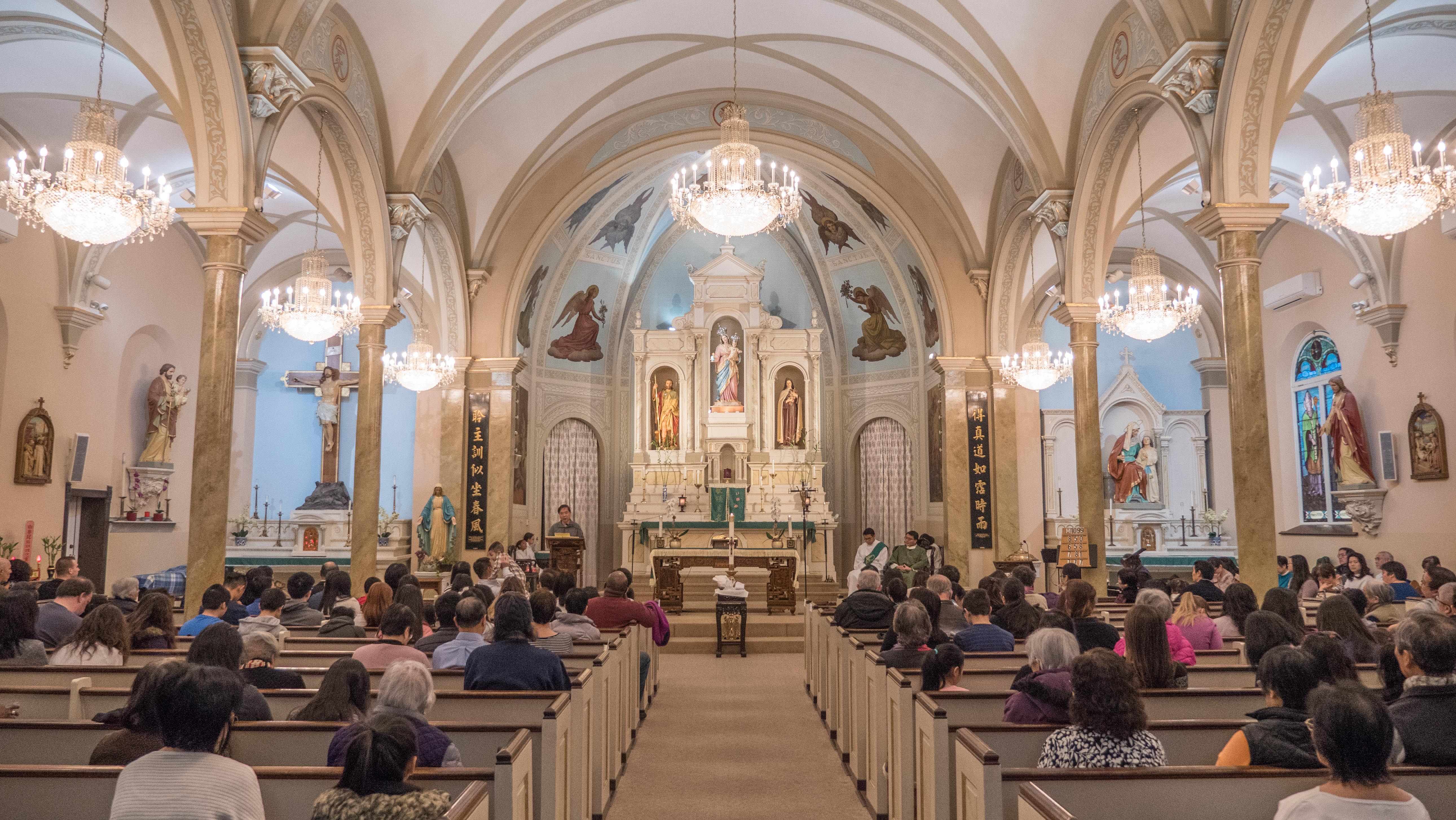Photos: DS Shin
The Last Holdouts is an occasional series where Chicago looks at the people, institutions, and groups that are sticking around while everything around them transforms. If you have ideas to pitch or submit, email holdouts@chicagomag.com.
A red brick church with a bell tower stands on Alexander Street in Chicago’s Old Chinatown. Stained glass windows filter light in to the 114-year-old building, and two small stone lions guard the entrance. With curly manes, the lions are nearly identical: one is female, with her paw resting on a cub, and the other is male, playing with a ball. These guardian lions are popular in Chinese Buddhism, but at St. Therese, they welcome parishioners to the only Chinese Catholic church in the Midwest.
Established in 1904, the building originally housed the congregation of Santa Maria Incoronata, serving the Italian community. The St. Therese Catholic Mission was formally erected in 1947 by then-Archbishop Samuel Stritch, as a way to serve the growing population of Chinese immigrants in Chicago; the parishioners met in a storefront church on Wentworth Avenue. As the community grew further, especially with an influx of people fleeing communist China, it needed more room for worshippers. By 1963, Santa Maria Incoronata was consolidated with another nearby church and the building was given to St. Therese. Despite the initial friction from the changes, the St. Therese Chinese community flourished, and Italian Americans still celebrate Masses and feast days at the Alexander Street church.
In the last 70 years, St. Therese has focused on providing resources to the community, especially for immigrants who are struggling to make it in a new country. The parish has Mandarin- and Cantonese-speaking volunteers who serve as translators at St. James Food Pantry; it holds a monthly gathering for Chinese-speaking university students; and the church gives referrals for English and citizenship classes, such as to the Chinese American Service League and the Pui Tak Center.
Chicago’s Chinatown is known as one of the few American Chinatowns that is welcoming new immigrants each year and maintaining its cultural identity, while many of its counterparts have been reduced to tourist attractions or gentrified. In fact, Father Francis Li, the pastor who has served St. Therese for over seven years, has seen his flock grow during his tenure. But, he notes that the area has experienced changes that have tested the church’s ability to evolve.
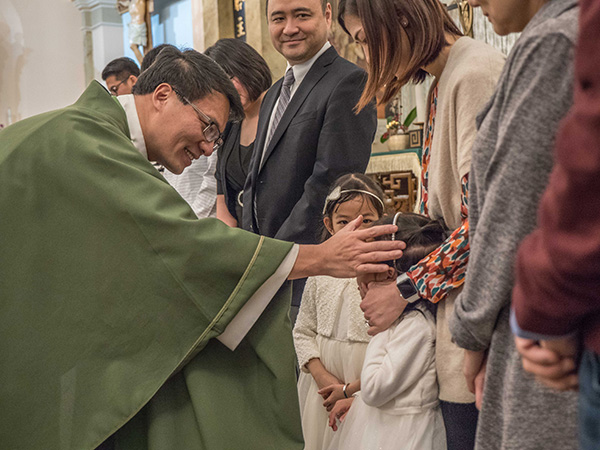
Most visibly (or audibly), Chinatown has seen an influx of Mandarin-speaking Chinese immigrants, who sometimes have trouble communicating with the Cantonese-speaking Chinese immigrants who once dominated this neighborhood. The church now serves over 200 families and hosts regular Masses in Mandarin, English, and Indonesian, in addition to Cantonese. Even as the immigrants’ languages change, Li says the newcomers are attracted to the church because they’re interested in learning more about the Catholic faith while maintaining a connection to their Chinese culture.
“It’s a challenge and I also see this as an opportunity,” Li says. “As a church, our mission is to serve, so the new immigrants, some of them are looking for meaning and purpose in their life. They want to know more about the Catholic church and God, so we try to provide some services to them. The limitation is we are small.”
For Darlene Chan, St. Therese has been her family all her life. Chan was born and raised in Chinatown, as were her parents. She grew up attending St. Therese, from her baptism, to attending school there, to her continued service and involvement there today. Her daughter Nicole was also baptized there, continuing a family tradition.
“St. Therese to me is like family, like home,” Chan says. “The community has been very welcoming. I wanted to share that faith with my family members and daughter. That need for spiritual growth—it has stuck with me throughout my life.”
Chan sits on the parish council, serves as a lector, and, for 11 years, taught young children as a catechist. She knows the church by heart, from the gold and white arches that hold the church up, to the crucifix on the left side of the church donated by Al Capone’s mother, to the guardian angels painted on the light blue dome above the sanctuary, to the gold Chinese characters above these arches that adorn the side of the church. They read, “We are one happy family with God and love.”
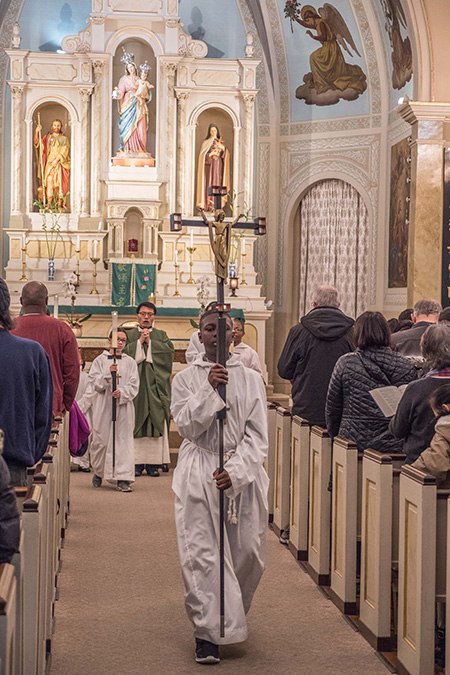
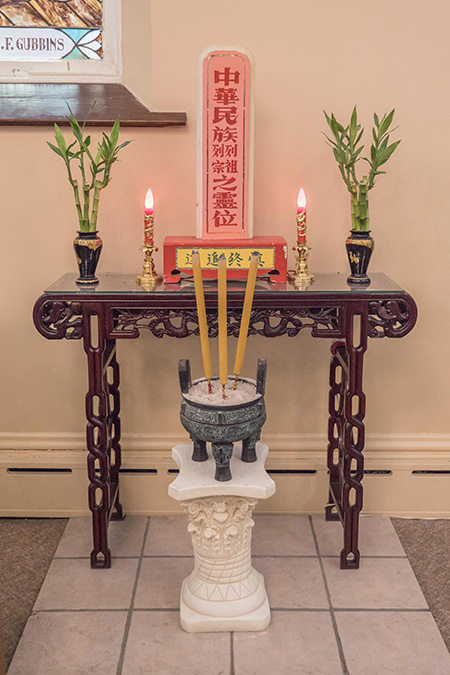
“I grew up there my whole life. It feeds people spiritually,” she says. “It’s heartwarming, letting them know they can come to our church in times of need. It’s a very tight-knit parish, but very diverse.”
Chan says she hopes that the parish continues to welcome newcomers, regardless of background. “Every time someone comes to our church, it’s a treasure,” Chan says. “We’re being fed spiritually. We come closer together. We’ve grown in numbers.”
Since its founding in 1947, the parish has been a stronghold in the community. Many of its parishioners are active in local politics, fighting for resources—like Ping Tom Memorial Park, which was built in 1991 after residents pointed out the neighborhood’s complete lack of open space and recreational facilities. In 2015, residents cheered the opening of a beautiful new Skidmore, Owings & Merrill-designed library. Today, they are fighting for a new high school.
The strength of the community is one reason that Chan has stayed in the city, even though she and her husband considered moving to the suburbs after they got married. She says her aunt told her to stay in Chinatown.
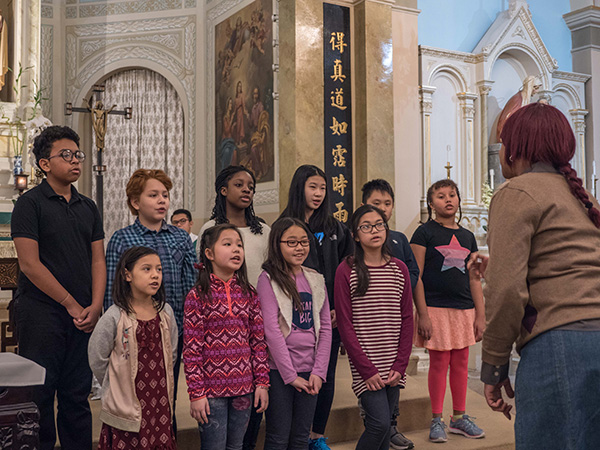
“She told me, ‘It will never lose its value. The Chinese are not going anywhere,’” Chan recounts. “She meant that Chinatown will never die. The Chinese are always coming and going.”
Chan stayed nearby, in Bridgeport, and eventually realized her aunt was completely right. While Chinatowns across the country fight the gentrification chipping away at their communities, the Chicago Chinatown is booming. The majority of Chinatown residents speak a Chinese dialect, and 65 percent are immigrants. Many Chinese Americans, like Chan, choose to stay in the neighborhood where they grew up, and if they do move out, they sell their homes back to the Chinese, which explains why homes in Chinatown are practically invisible on apartment rental sites.
Like the neighborhood that gives the church its identity, St. Therese is going strong. “I’m told our church will never close,” says Chan. "It's the only Chinese Catholic Church in the Midwest and is the Archdiocesan Center for Chinese Apostolate that serves the Chinese in the Midwest. It's doing well…It's flourishing."
